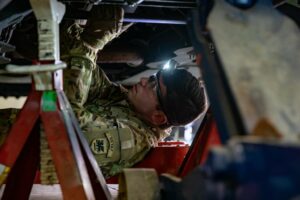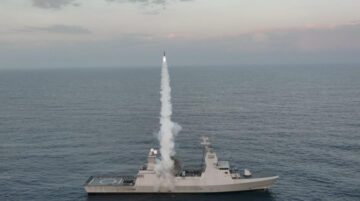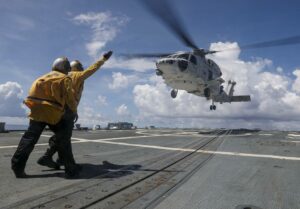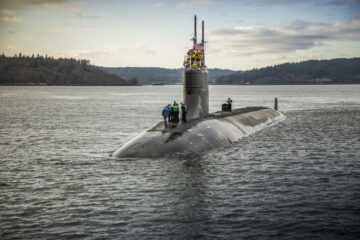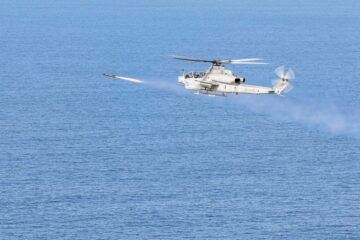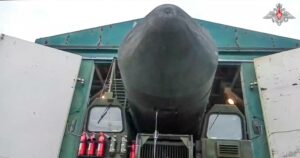
Vance Air Force Base in Oklahoma is inspecting its entire fleet of T-6 Texan II training aircraft for damage after a severe thunderstorm swept through on July 21, delaying undergraduate pilot training by at least two weeks.
It’s the latest hiccup in pilot training as the service pushes to graduate nearly 1,500 new aviators this fiscal year, hoping to chip away at a perennial pilot shortage.
The thunderstorm battered the T-6s with winds over 70 mph, blowing off their protective covers and prompting concerns about debris in the engines and other structural problems, the Air Force said.
At least 12 T-6s require intensive repairs before they can return to flight, base spokesperson Terri Schaefer said. Local leaders have opted to check the entire fleet of 99 Texan IIs for structural and mechanical damage as a safety precaution.
The 71st Flying Training Wing resumed flight operations on Sunday, two days after the storm, while Air Force mechanics and contractors continue inspecting aircraft. Schaefer said Vance expects to return to normal operations by Aug. 4.
T-6s were the only airframe affected at Vance, which also flies the T-1 Jayhawk and T-38 Talon trainers. It’s too early to tell how much it may cost to repair them.
It’s unclear what longer-term ripple effects the storm may have on the pilot training process, which requires classes of students to move on to their next aircraft before new airmen are allowed to start. More than 260 undergraduate students are currently assigned to Vance, Schaefer said.
The T-6 is the first military aircraft a new student touches as part of the undergraduate pilot training curriculum. Earning pilot’s wings in the T-6 takes about seven months, at which point a trainee is selected to continue on the fighter-bomber track or the mobility track.
Slowing or pausing T-6 flights can cause repercussions farther down that line.
“The pilot training pipeline has been impacted by this storm, and officials are discussing how to make up for the time lost to meet production numbers,” Vance spokesperson Tech. Sgt. James Bolinger said.
This isn’t the first time Mother Nature has intervened in pilot training.
In February 2016, a hailstorm tore through Laughlin AFB, Texas, pelting the training base with chunks of ice that caused enough damage to ground 80% of its aircraft. In October 2018, Hurricane Michael devastated Tyndall AFB, Florida, the Air Force’s sole training site for the F-22 Raptor fighter fleet. And several training installations were among those hit by Winter Storm Uri and other squalls in early 2021.
The Air Force is also working through delays elsewhere in the training pipeline. Earlier this year, the service projected a slowdown in T-38 engine repairs would hinder aircraft availability until at least September, among other issues related to staffing and the inventory’s age.
Rachel Cohen joined Air Force Times as senior reporter in March 2021. Her work has appeared in Air Force Magazine, Inside Defense, Inside Health Policy, the Frederick News-Post (Md.), the Washington Post, and others.
- SEO Powered Content & PR Distribution. Get Amplified Today.
- PlatoData.Network Vertical Generative Ai. Empower Yourself. Access Here.
- PlatoAiStream. Web3 Intelligence. Knowledge Amplified. Access Here.
- PlatoESG. Automotive / EVs, Carbon, CleanTech, Energy, Environment, Solar, Waste Management. Access Here.
- BlockOffsets. Modernizing Environmental Offset Ownership. Access Here.
- Source: https://www.defensenews.com/news/your-air-force/2023/07/27/thunderstorm-damage-to-vances-t-6-fleet-will-slow-pilot-training/
- :has
- :is
- $UP
- 1
- 12
- 13
- 2016
- 2018
- 2021
- 500
- 70
- a
- About
- After
- age
- AIR
- Air Force
- aircraft
- allowed
- also
- among
- and
- appeared
- ARE
- AS
- assigned
- At
- Aug
- availability
- away
- base
- been
- before
- Blowing
- by
- CAN
- Cause
- caused
- check
- chip
- classes
- cohen
- Concerns
- continue
- contractors
- Cost
- covers
- Currently
- Curriculum
- damage
- Days
- Defense
- delays
- discussing
- down
- Earlier
- Early
- Earning
- effects
- elsewhere
- Engine
- Engines
- enough
- Entire
- expects
- February
- First
- first time
- Fiscal
- FLEET
- flight
- Flights
- florida
- flying
- For
- Force
- Frederick
- graduate
- Ground
- Have
- Health
- her
- hinder
- hoping
- How
- How To
- HTTPS
- hurricane
- ICE
- ii
- Iis
- images
- impacted
- in
- inside
- IT
- ITS
- james
- joined
- jpg
- July
- latest
- leaders
- least
- Line
- local
- lost
- magazine
- make
- March
- May..
- mechanical
- mechanics
- Meet
- Michael
- Military
- mobility
- months
- more
- mother
- move
- much
- Nature
- nearly
- New
- next
- normal
- numbers
- october
- of
- off
- officials
- Oklahoma
- on
- only
- Operations
- or
- Other
- Others
- over
- part
- pilot
- pipeline
- plato
- Plato Data Intelligence
- PlatoData
- Point
- policy
- Post
- problems
- process
- Production
- projected
- Protective
- related
- repair
- repercussions
- reporter
- require
- requires
- return
- Ripple
- Safety
- Said
- selected
- senior
- September
- service
- seven
- several
- severe
- site
- slow
- spokesperson
- staffing
- start
- Storm
- structural
- Student
- Students
- takes
- tech
- tell
- texas
- than
- that
- The
- The Washington Post
- their
- Them
- they
- this
- this year
- those
- Through
- time
- times
- to
- too
- track
- Training
- two
- until
- washington
- washington post
- Weeks
- were
- What
- which
- while
- will
- winds
- Wing
- Winter
- with
- Work
- working
- would
- year
- zephyrnet

